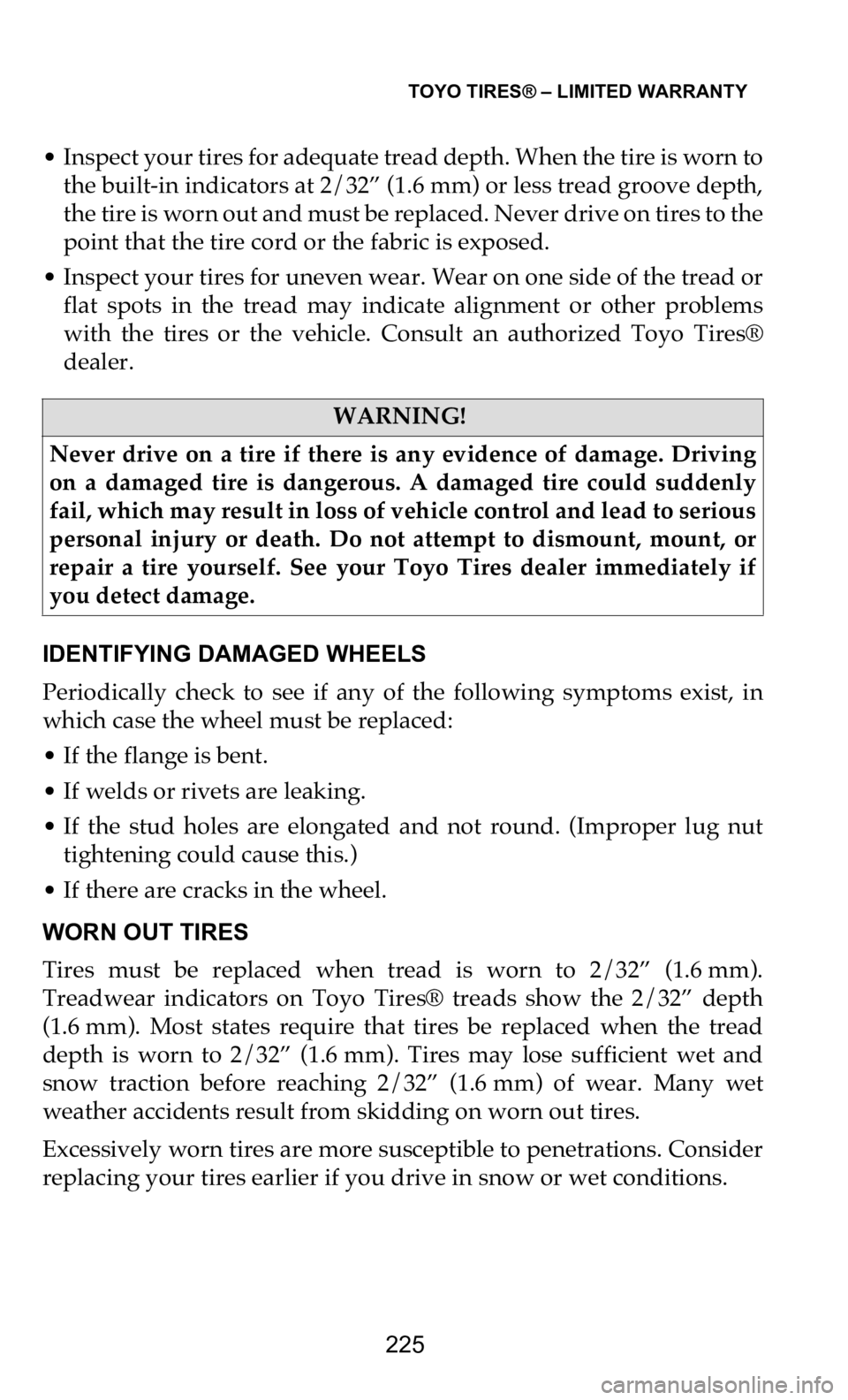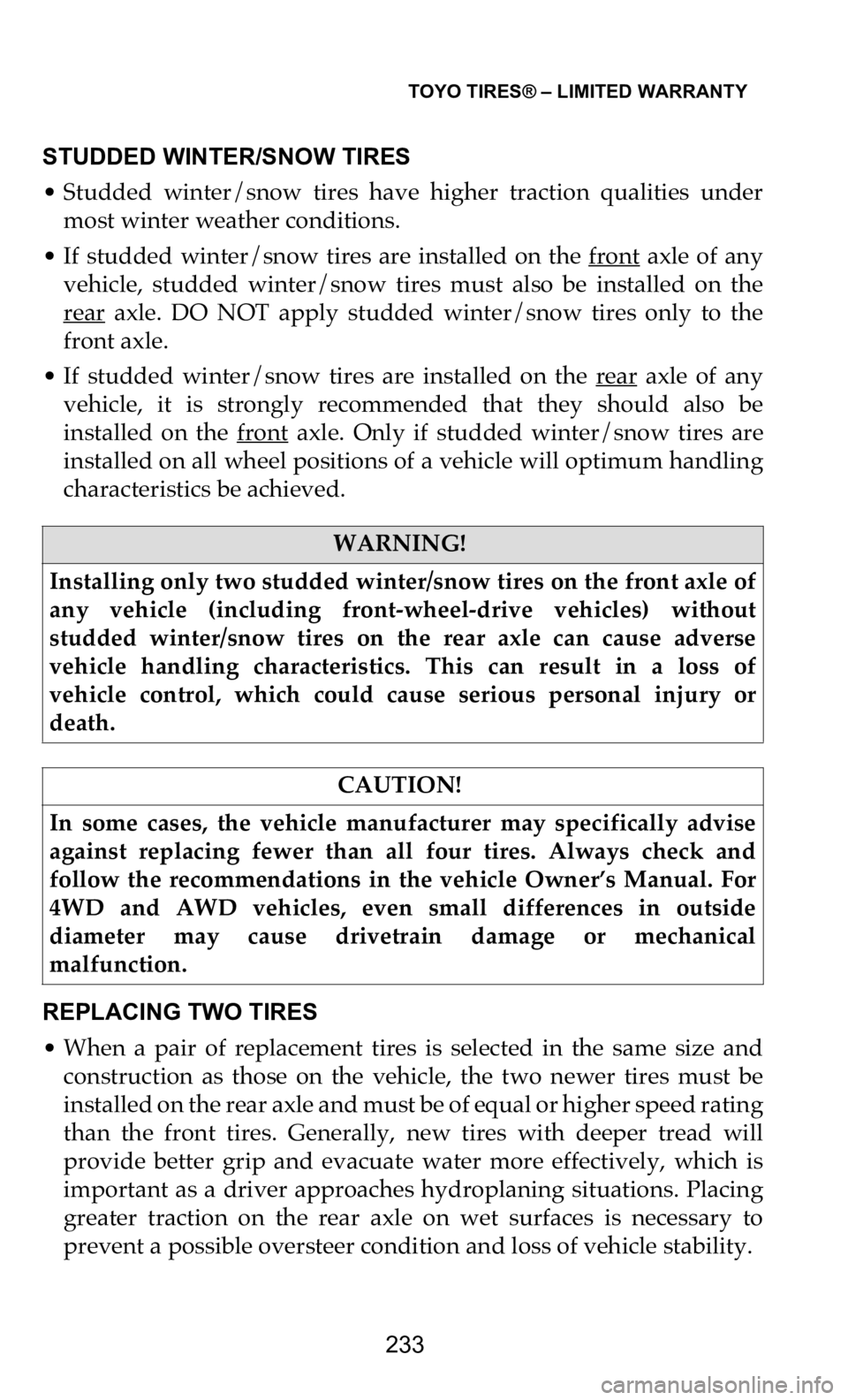traction control DODGE DURANGO 2021 Vehicle Warranty
[x] Cancel search | Manufacturer: DODGE, Model Year: 2021, Model line: DURANGO, Model: DODGE DURANGO 2021Pages: 262, PDF Size: 10.42 MB
Page 226 of 262

TOYO TIRES® – LIMITED WARRANTY
225
• Inspect your tires for adequate tread depth. When the tire is worn to
the built-in indicators at 2/32” (1.6 mm) or less tread groove depth,
th
e tire is worn out and must be replaced. Never drive on tires to the
point that the tire cord or the fabric is exposed.
• Inspect your tires for uneven wear. Wear on one side of the tread or
f
lat spots in the tread may indicate alignment or other problems
with the tires or the vehicle. Consult an authorized Toyo Tires®
dealer.
IDENTIFYING DAMAGED WHEELS
Periodically check to see if any of the following symptoms exist, in
w h
ich case the wheel must be replaced:
• If the flange is bent.
•
If welds or rivets are leaking.
•
If the stud holes are elongated and not round. (Improper lug nut
t
ightening could cause this.)
• If there are cracks in the wheel.
W
ORN OUT TIRES
Tires must be replaced when tread is worn to 2/32” (1.6 mm).
Tr
eadwear indicators on Toyo Tires® treads show the 2/32” depth
(1.6 mm). Most states require that tires be replaced when the tread
de
pth is worn to 2/32” (1.6 mm). Tires may lose sufficient wet and
sn
ow traction before reaching 2/32” (1.6 mm) of wear. Many wet
we
ather accidents result from skidding on worn out tires.
Excessively worn tires are more susceptible to penetrations. Consider
re
placing your tires earlier if you drive in snow or wet conditions.
WARNING!
Never drive on a tire if there is any evidence of damage. Driving
on
a damaged tire is dangerous. A damaged tire could suddenly
fail, which may result in loss of vehicle control and lead to serious
personal injury or death. Do not attempt to dismount, mount, or
repair a tire yourself. See your Toyo Tires dealer immediately if
you detect damage.
Page 234 of 262

TOYO TIRES® – LIMITED WARRANTY
233
STUDDED WINTER/SNOW TIRES
• Studded winter/snow tires have higher traction qualities under
m
ost winter weather conditions.
• If studded winter/snow tires are installed on the f
ront axle of any
vehicle, studded winter/snow tires must also be installed on the
rear axle. DO NOT apply studded winter/snow tires only to the
front axle.
• If studded winter/snow tires are installed on the rear axle of any
vehicle, it is strongly recommended that they should also be
installed on the
front axle. Only if studded winter/snow tires are
installed on all wheel positions of a vehicle will optimum handling
characteristics be achieved.
REPLACING TWO TIRES
• When a pair of replacement tires is selected in the same size and
c
onstruction as those on the vehicle, the two newer tires must be
installed on the rear axle and must be of equal or higher speed rating
than the front tires. Generally, new tires with deeper tread will
provide better grip and evacuate water more effectively, which is
important as a driver approaches hydroplaning situations. Placing
greater traction on the rear axle on wet surfaces is necessary to
prevent a possible oversteer condition and loss of vehicle stability.
WARNING!
Installing only two studded winter/snow tires on the front axle of
an
y vehicle (including front-wheel-drive vehicles) without
studded winter/snow tires on the rear axle can cause adverse
vehicle handling characteristics. This can result in a loss of
vehicle control, which could cause serious personal injury or
death.
CAUTION!
In some cases, the vehicle manufacturer may specifically advise
ag
ainst replacing fewer than all four tires. Always check and
follow the recommendations in the vehicle Owner’s Manual. For
4WD and AWD vehicles, even small differences in outside
diameter may cause drivetrain damage or mechanical
malfunction.
Page 244 of 262

TOYO TIRES® – LIMITED WARRANTY
243
• Follow recommendations in the vehicle Owner’s Manual for winter
tires, studs, and chains.
• Consult your tire dealer, the Rubber Manufacturers Association
w
ebsite
www.rma.org
, or your state’s Department of Transportation
(DOT) for information regarding regulatory and seasonal restric -
tions for stud usage.
• Also see the “Tire Mixing” section in this manual for more details.
•
Toyo Tires recommends that snow tires be installed in matched sets
o
f four.
ADVERSE WEATHER DRIVING
Take special care when driving in adverse weather conditions.
• Rain and snow – Driving in rain or snow considerably reduces the
t
raction between your tires and the road surface. You must always
reduce your speed to allow additional stopping distance between
you and the vehicles ahead of you.
• Hydroplaning and wet weather driving – Hydroplaning occurs on
w
et roads and refers to the loss of tire contact with the road due to
the build-up of water between the tire contact patch and the road
surface. Three main factors affect hydroplaning and, consequently,
your tire traction on wet roads:
1. Vehicle Speed – As speed increases, wet traction is considerably
r
educed.
2. Water Depth – The deeper the water, the sooner your tires will lose
t
raction. Even thin water layers can create sufficient lubrication to
cause traction loss at low speeds, depending on road conditions.
3. Tire Tread Depth – As your tires wear down, their decreased ability
t
o resist hydroplaning can result in a complete loss of traction and
vehicle control. You should always reduce your speed with consid -
eration for the traffic around you.
• Driving on ice and snow – Your all-season tires were designed to
p
rovide higher levels of snow traction compared to non-all- season
tires. You have all-season tires if you find the letters “M&S” are
molded into the sidewall near the bead. These letters mean “Mud and
Snow.” Tires designed for use in severe snow conditions generally
have tread patterns, structure, and materials for giving superior
performance. These tires are marked with the “M&S” designation
Page 252 of 262

TOYO TIRES® – LIMITED WARRANTY
251
TYPICAL LIGHT TRUCK TIRE
UNIFORM TIRE QUALITY GRADING (UTQG)
The Uniform Tire Quality Grading (UTQG) standards are intended to
a s
sist you in making an informed choice in your purchase of
passenger car tires by providing information indicating relative
performance in the areas of treadwear, wet stopping traction, and
temperature resistance. All passenger car tires must conform to
federal safety requirements in addition to these grades.
• Treadwear - The treadwear grade is a comparative rating based on
t
he wear rate of the tire tested under controlled conditions on a spec -
ified government test track. For example, a tire graded 200 would
we
ar twice as long on the government course as a tire graded 100. It
is wrong to link treadwear grades with your projected tire mileage.
The relative performance of the tires depends upon the actual condi -
Page 253 of 262

TOYO TIRES® – LIMITED WARRANTY
252
tions of their use and may vary due to driving habits, service prac-
tices, differences in road characteristics, and climate.
• Traction - The traction grades from highest to lowest are AA, A, B,
a
nd C, and they represent the tire’s ability to stop on wet pavement
as measured under controlled conditions on specified government
test surfaces of asphalt and concrete.
• Temperature - The temperature grades are A (the highest), B, and C,
r
epresenting the tire’s resistance to the generation of heat and its
ability to dissipate heat when tested under controlled conditions on
a specified indoor laboratory test wheel. Sustained high tempera -
tures can cause the materials of the tire to degenerate and reduce tire
li
fe, and excessive temperature can lead to sudden tire failure. The
grade C corresponds to a level of performance that all passenger car
tires must meet under the Federal Motor Vehicle Safety Standard
No. 139. Grades B and A represent higher levels of performance on
the laboratory test wheel than the minimum required by law.
• D OT Quality Grades - All passenger car tires must conform to
f
ederal requirements in addition to these grades. CAUTION!
The traction grade assigned to tires is based on locked braking
( s
traight ahead) traction tests and does not include cornering
(turning) traction.
WARNING!
The temperature grade is established for a tire that is properly
in
flated and not overloaded. Excessive speed, underinflation, or
excessive loading either separately or in combination can cause
heat buildup and possible tire failure. This can cause an accident,
which could lead to serious personal injury or death.